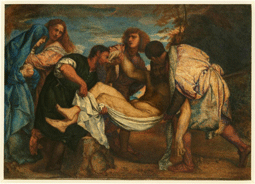'The Entombment of Christ', after Titian
Frank Randal (1852-1917). Watercolour on paper, 1886
WorkIn this copy of Titian's The Entombment of Christ, the figures from left to right are: the Madonna, Mary Magdalene, Joseph of Arimathea, St John, Christ and Nicodemus.Ruskin on The Entombment of ChristThe original painting by Titian is kept in The Louvre. On seeing it in Paris in 1844, Ruskin wrote these notes in his diary:'the palest flesh is solemn, and dark, in juxtaposition with bright golden white drapery. All the masses broad and flat, the shades grey, the outlines chaste and severe [...] [T]he head of Christ is entirely sacrificed, being put in the deepest possible shade, against clear sky, and it is disagreeable in itself. The head of the St. John and St. Joseph are however grand conceptions, and the foliage of the landscape graceful in the extreme. It is curious that in this broadest of all broad pictures there should be one of the most delicate transitions of colour I remember. It begins with St. John's robe-crimson, in shade intensely dark; then same in light. Then St. Joseph's face nearly purely crimson, carried off by the juxtaposition of the robe. Then his neck, paler; then his arm, paler still, which joins robe of Magdalen, which is warmed near it by a few reflected lights, but in its palest part, joins and unites with the corpse-cold hand of the Madonna.The colour throughout amounts to little more than exquisite staining. The bright draperies and the chequers upon them exquisitely delicate, and finished and full of hue, appear the result of the same operation as the dark retiring ground; incorporated with it, and showing no edge in many places. The most palpable piece of painting is the white drapery under the Christ which is visibly superimposed, and has a raised edge.' (Works, 12, p. 452). A photograph of Titian's original can be viewed on The Louvre's website.
ArtistFrank Randal (1852-1917) was born in Paddington, London, to Charles Hayter Randal and Frances (née Arnold). Collection of the Guild of St George, Museums Sheffield
Little is known of Randal, but Ruskin commissioned more works from him than any other artist in the Ruskin Collection. He caught the attention of Ruskin in 1881, who started to commission work from him. This continued until 1887. Over this time, he produced at least 137 drawings and watercolours for the Guild. Randal later worked for Sir Sydney Cockerell, painting architectural records for the Society for the Preservation of Pictorial Records of Ancient Works of Art and painting commissions. This included a number for a prominent Sheffield art collector, George Parkes Wall, who was founder of the Pluto Steelworks. Randal had a brother Charles (described in the 1881 census as a photographer, and in the 1891 census as an artist and sculptor), and a sister, Fanny Scott Randal. A sketch of W. G. Collingwood, Ruskin and Randal was drawn on a letter that Charles sent to Fanny.-----
[The information concerning Randal's family connections was kindly supplied by Philippa Robertson of Morrinsville, New Zealand, the great great grandaughter of Randal's uncle, John Lawrence Randal, an architect at Shrewsbury.]----- Ruskin on TitianRuskin described the Venetian master Titian (1488-1576) as the greatest painter who ever lived, and The Entombment of Christ as 'The finest Titian in the Gallery [the Louvre], glowing, simple, broad and grand.' (Works, 11, p. 410). He admired Titian particularly because of his use of colour; the gradation of different tones, the luminous shades in his drapery and the striking effect of his 'chiaroscuro' or relationship between light and dark areas. |



















